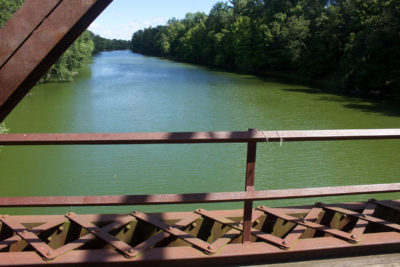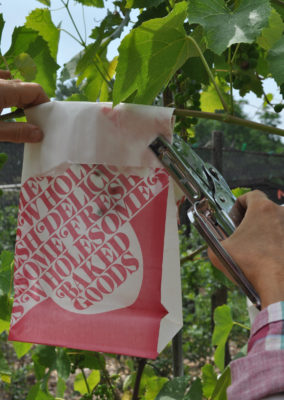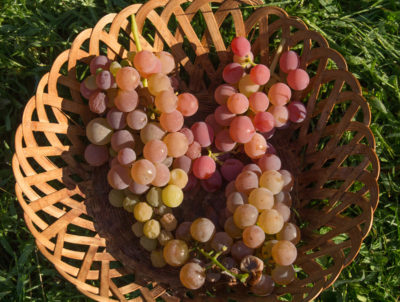BACTERIA AND FUNGI, AND GRAPES, OH MY
Upcoming Fall Fruit Workshop
See web page https://leereich.com/workshops for details.
The River Runs Green
Crossing the bridge over the Wallkill River on my way home, I glance to my right to admire the river itself. What a beautiful color it has turned, a bright turquoise. Ponds I pass also have taken on this bright complexion, for which we can thank, or curse, organisms known as blue-green algae (heretofore referred to as BGA).
Algae, they are not, though. BGA are bacteria known as cyanobacteria. “Algae” generally refers to eukaryotes, organisms with distinct nucleii and specialized organelles. BGA are prokaryotes, lacking such features.
BGA can be toxic, which is good reason to curse them. Drinking or swimming in contaminated waters can cause problems to humans and other animals, including dogs, who seem to be otherwise able to drink almost any water without ill effect. The “cyan” in the name and the criminal cyanotoxins are not at all related to cyanide. The name come from “cyan,” which is the color blue-green.
Many kinds of BGA are found throughout the world, often in extreme conditions. Not all produce cyanotoxins; some produce them only under certain conditions. Not all are even blue-green; the Red Sea gets its color from Trichodesmium erythraeum, a species of BGA. Certain conditions cause “blooms,” such as those I was admiring in the river and ponds. Here, it’s probably a combination of relatively dry conditions resulting in shallow and calm waters along with the usual influx of nutrients, mostly phosphorus and mostly from farms, septic systems, and lawns.
BGA are photosynthetic organisms, just like plants, imbibing carbon dioxide during the day and spewing out oxygen. These primitive organisms, “in the beginning,” were important for oxygenizing the Earth’s atmosphere, thus stimulating biodiversity. We could praise them for sequestering carbon.
Agriculturally, some cyanobacteria are important because they can convert atmospheric nitrogen into forms of nitrogen that plants can use. Although these cyanobacteria are especially important for maintaining fertility of rice paddies, they are present, to some degree, in virtually all soils. Some research even points to benefits of inoculating soils with these organisms.
Bags vs. Fungi
So now I’m home, my head out of the soil, and admiring my grape vines. The dry weather has been almost as good for the grapes as it has been for the cyanobacteria. Dry weather minimizes grape diseases and abundant sunlight puts flavor and sweetness into the berries. With annual applications of mulch around the grapes and their far reaching roots, I never worry about my established vines being thirsty.
Back in early summer, we went to the trouble of affixing paper “delicatessen” bags around 100 bunches. Now is the payoff. Peeling back the paper usually reveals perfect, full, bloom-dusted bunches of especially delectable grapes. “Especially delectable” because I can let these protected bunches hang longer on the vines than unbagged bunches, which do have some disease and are prey to bees, wasps, and birds. These bagged grapes get dead ripe before being harvested.
The bagging isn’t really all that troublesome. We just select downward hanging bunches, made easier because I train fruiting canes horizontally across a 5-wire, flat trellis, and remove any tendrils or leaves opposite the bunches. After making a slit down each side of a bag, the slitted opening is slid up the cane on either side of the bunch, the top of the bag is folded over, and then the flap stapled down on either side — well worth the minute or so it takes from selection to finish bagging a bunch.
Grapes to Keep
With many varieties of established grapevines, I can cut down any whose flavor is not up to snuff or that don’t produce well without having to bemoan waiting for new ones to start bearing. The “keepers” tide me over. Variety choice is somewhat limited here because of winter cold and because cooler, damp air collects in this valley, promoting disease, abetted by inoculum from all the wild grape vines grappling high into neighboring trees along the forest edge.

Glenora and Vanessa seedless grapes
I’ll be doing a Henry IVth on Mars and Concord.
Some of my current favorite varieties are Vanessa, Somerset Seedless, and Glenora, all seedless varieties. Of the three, Glenora has the best flavor, Vanessa the best texture, but they’re all very good. Some of my favorite seeded varieties are Alden, whose corpulent berries hang in large bunches, and Brianna, which isn’t quite ripe yet, but every year has rewarded us with foxy-flavored, pale green berries.
Still to come for this season are Edelweiss, which has a rich, very foxy flavor but has not been very productive the last few years, and Brianna, with its own rich flavor not so dependent on foxiness.
A few more years of tasting and watching will dictate whether New York Muscat, Cayuga White, Bertille Seyve 2758, Lorelei, Reliance, Swenson White, and Wapanuka keep their home here. They’re all good grapes, but why grow good grapes when I could grow great grapes from among the 5,000 or so varieties (not all adaptable here, of course)?
(That “foxy” flavor I kept referring to is characteristic of many American grapes, and is typified by the variety Concord. No one is sure how “foxy came to describe that flavor.)

